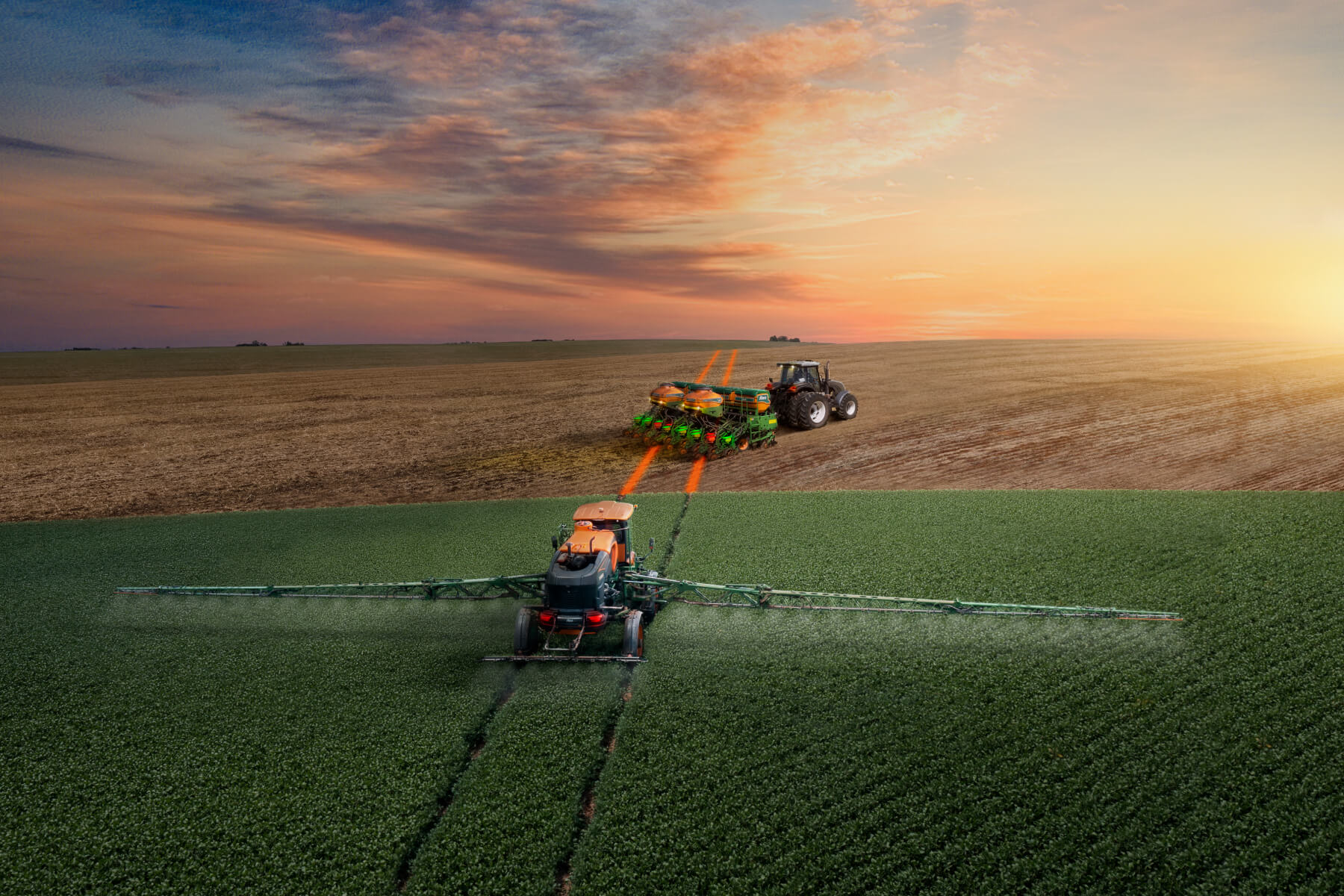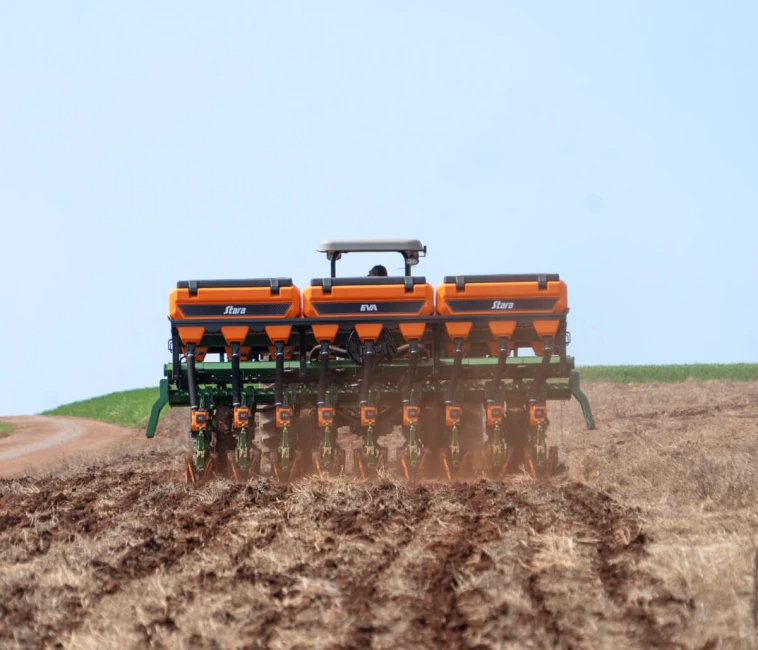Efficiency to each planted row means less waste and higher yields per hectare. During mechanical operations, minimum variations in the depth or spacing can impair the seed bed and affect the final yield of the crop field.
The planter is the centre of this step. It sets the sowing uniformity, the emergency rate and the usage of the agricultural inputs, factors that when combined, set the production potential of the harvest.
Studies carried out by the Universidade Federal de Viçosa (UFV) show that the adjustment and operation speed directly influence on the mechanical and power efficiency of the seeders, affecting the tractor fuel consumption and seed placement uniformity.
In the field, this relation results in yield: well-adjusted implements and operate at proper speeds plant highly precisely and deliver less waste.
In this article, you will learn five factors that most influence on the efficiency of the planters and how the Stara technologies help the farmer to transform each planted meter in actual performance.
What is planter operation efficiency?
The planter efficiency can be assessed into two factors: operational and agronomic.
The first one is related to the operation capacity (hectares per hour), tractor fuel consumption, and stopped time. The second one is about the planting quality, especially the seed placement uniformity, depth, and spacing between the seeds.
As says Matheus Henrique Baumgratz, Agronomist Engineer and Stara Product Marketing Analyst:
An efficient planter ensures a uniform planting operation with the ideal depth and no failures. To accomplish that, it’s crucial to consider the soil type, the correct adjustment, and have all maintenance services performed.
When these elements work together, the farmer ensures a balance seed bed, healthy plants, and higher yields.
See below, five factors that most influence on the efficiency of the planters, and how Stara incorporates technology to each one of them to ensure consistent results in the field.
1. Planter adjustment
The planter adjustment is the first step for an efficient planting. It makes sure of the ideal depth of the seeds and uniform seed placement, avoiding failures or doubles. Among the main adjustments, there are:
- pressure of the springs;
- calibration of the meter units;
- adjustment of the coulter discs;
- inspection of the closing wheels.
Matheus Henrique Baumgratz, Agronomist Engineer and Stara Marketing Product Analyst states that before starting the planting operation, it’s essential to correctly calibrate the products (seeds and fertilizers), check the implement leveling, and inspect the components for wear.
Additionally, technologies such as the pneumatic meter - DPS-E and the curve compensation system allow the uniform seed placement even in bumpy curves. Baumgratz explains:
The DPS-E ensures the same seed placement from one implement end to another, even in curves. It prevents failures and overlap, resulting in seed savings and planting quality.
2. Quality of the seeds and agricultural inputs
Seeds in different sizes or weight make the function of the meter units harder and impair the sowing precision.
For this reason, it’s essential to use standard and well-treated seeds, which are proper to the crop and meter type (mechanical or pneumatic).
On the Stara summer planters, Eva, Cinderela, Princesa, Estrela, and Absoluta, the pneumatic meter units deliver high precision for seed placement of corn and soybeans, ensuring the best seed bed and less waste.
Alternatively, on Guapa and Guapita winter planters, the metering is carried out in kg/ha, ensuring uniform cover for smaller seeds, such as wheat, oats, and barley.
3. Soil conditions and area preparation
The physical condition of the soil directly influences on the planter efficiency. Compacted, too wet soils or with excess of straw residues complicate the penetration of the discs and impair the seed placement.
At Stara, the agricultural implements feature robust straw cutting systems and pressure adjustments that adapt to the soil type.
In addition, using precision agriculture with controllers such as Topper allows you to map management zones and adjust the operation according to each area needs, boosting the agronomic efficiency.
4. Planting speed
The speed is one of the factors that most affect the sowing quality. Operating above the recommended limit could cause variation in the seed placement and germination failures, especially in bumpy terrains.
Thanks to the Stara technologies, such as the Control System and the Row-by-Row Shut-Off System, you can keep the ideal operation speed and reduce the operator’s effort during long operation hours.
These resources help to balance the yield and precision, ensuring maximum performance from the agricultural implement.
Learn more: Agricultural controller: how does Stara Topper work?
5. Preventive maintenance of the planter
The preventive maintenance is crucial to keep the planter highest level of efficiency. Discs, roller bearings, conducting tubes, and hoses need to be inspected before and during the planting process.
The Stara Maintenance Program is one of the services that ensure this constant performance, avoiding unexpected stops and prolonging the lifespan of the agricultural pieces of equipment.
As Baumgratz said “a well-adjusted and well-maintained planter is the key to successful planting.”
Learn more about planters
On Stara blog, experts share hints and insights about the daily life with planters and other agricultural machinery. Also, check out:
- What’s the best planter for your crop? | Stara
- How to increase the precision of the planters in the field? | Stara
- Seeder or planter: what’s the difference? | Stara
How to increase the precision of the agricultural technology?
Stara provides integrated solutions of precision agriculture that boost planting efficiency and reduce operating costs in all steps of the process.
More than individual resources, these technologies work connected, optimizing the planter performance and the operator’s job in the field.
Control System:
Variable-rate planting allows for instantaneous adjustment of seeds, with adjustments of 0.01 in 0.01 seeds per meter, ensuring the ideal spacing between plants.
Row-by-Row Shut-Off System:
It automatically shuts off the planting row units in areas that have already been planted, which reduces costs, improves the seed bed uniformity and boost yield, eliminating the competition between plants.
The system is higher efficient in boundaries, delivering average seeds savings of 5.03%.
Zero Crop Damage:
It automatically stops the planting process where the agricultural self-propelled sprayers and self-propelled spreaders will further pass on, preventing the waste of seeds to easily control the machine traffic. The result is a more uniform and productive area without any waste of seeds. Stara planter that features the Zero Crop Damage
Stara planter that features the Zero Crop Damage
Get to know the Stara Zero Crop Damage technology
Conecta Stara:
It’s a remote technical assistance service that allows the real-time diagnostics directly from the factory. This connectivity speeds up the customer service and ensures that the agricultural machines deliver maximum performance.
Operator’s Portal:
It’s a free platform that provides constant technical training to farmers and operators. By means of training and educational materials, the Operator’s Portal is an additional tool to use the on-board technologies correctly and boost the operating yield of the machines.
These features, combined with the operator’s expertise and support from Stara specialized technical assistance, ensure more precise, sustainable, and productive planting.
Conclusion
In this article, you’ve seen how planter efficiency results from a combination of factors, from proper adjustment and maintenance to the use of on-board technology.
Providing a complete line of agricultural machines, Stara has different solutions for different crops, areas, and production needs. More than power, it’s technology and precision in favor of the farmer.
Frequently asked questions about the efficiency of the planters
1. How does the adjustment influence on the planter efficiency?
The adjustment is the start point for an efficient planting process. Wrong adjustments in the pressure of the springs, coulter discs, or meter units can impair the depth and uniformity of the seed placement.
2. What’s the ideal planting speed?
The speed depends on the soil type, crop type, and planter configuration. In general, operating above the limit recommended by the manufacturer can cause failures and overlap of seeds.
3. When has the planter maintenance carried out?
The preventive maintenance should be carried out before and during the planting period. It’s crucial to inspect the discs, roller bearings, conducting tubes, and springs to avoid unexpected stops.
Did you like the hints and want to find out the agricultural machine that best suits your crop field?
Stop by a Stara dealer and find the most suitable equipment to boost your crop production. Request a quotation.










